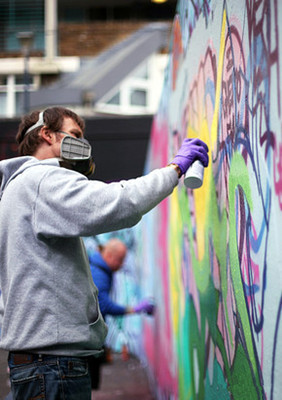涂鸦
The writing's on the wall
墙上文化
Having turned respectable, graffiti culture is dying
涂鸦文化获得体面,然濒临灭绝
LONDON'S fastest-changing art gallery is hidden in a sunken ball court on a housing estate in Stockwell, southLondon. On a sunny Sunday afternoon six or seven men, mostly in their 30s, are busy painting the walls with new designs. They have put up cartoons, names written in elaborate, multicoloured lettering and clever perspective tricks. Tins of spray paint and beer stand on the ground; ladders lean against the paintings. The atmosphere is not unlike that of a golf course: a mix of concentration and blokey relaxation.
伦敦的艺术展瞬息万变,这次则在伦敦南部斯托克维尔住宅区的一个地下球场举行。一个阳光明媚的周日午后,六七个30多岁的男子把自己的新设计画在墙壁上。他们在上面画了卡通图,精心设计的名字、色彩缤纷的字母和巧妙的错觉图。地上摆着一瓶瓶喷漆和啤酒,扶梯靠在墙上。这场景和高尔夫球场一样:是一种专注力和娱乐休闲的并存体。

Graffiti painting is traditionally a daredevil pursuit. Teenagers dodge security guards to put their names on trains and buses. But over the past decade that has all but disappeared fromBritain's cities. Between 2007 and 2012 the number of incidents of graffiti recorded by the British Transport Police fell by 63%. A survey by the environment ministry shows that fewer places are blighted by tags than ever. Graffiti are increasingly confined to sanctioned walls, such as the Stockwell ball courts. In time the practice may die out entirely.
一般来讲,涂鸦画可谓是一种不计后果的活动。年轻人们会避开保安,把它们的名字画上火车和巴士。但在过去的十年,这种现象在英国的城市已经消失了。从2007到2012年,违反英国交通法规的涂鸦案件下降了63%。环境部的调查显示,比起以前,受到标语破坏的地方越来越少。现在,涂鸦画日益局限在那些允许被涂画的墙上,比如斯托克维尔的球场。假以时日,这种行为可能会完全消亡。
The most obvious reason for the decline in tagging and train-painting is better policing, says Keegan Webb, who runs The London Vandal, a graffiti blog. Numerous CCTV cameras mean it is harder to get away with painting illegally. And punishments are more severe. Once-prolific taggers such as Daniel Halpin, who painted his pseudonym “Tox” all overLondon, have been given long prison sentences. British graffiti artists who want to paint trains usually go abroad to do it these days, says Mr Webb.
Keegan Webb,一个经营名叫“伦敦文化艺术破坏者”的涂鸦博客的博主说,绘名和铁皮车涂鸦风靡程度下降最主要的原因是政策法规更加完备。非法在墙上绘图越来越难以逃离无处不在的中央电视台摄像头,相应的惩罚也更加严重了。多产的绘名艺人Daniel Halpin把他的笔名“Tox”涂遍了整个伦敦,因此被判长期监禁。Mr Webb说近来想去涂画铁皮火车的英国的涂鸦艺人通常都会选择出国。
A generational shift is apparent, too. Fewer teenagers are getting into painting walls. They prefer to play with iPads and video games, reckons Boyd Hill, an artist known as Solo One, who in effect runs the Stockwell ball courts. Those who do get involved tend to prefer street art to graffiti proper (which purists define as letters and names, however elaborately drawn). Some have gone to art school and want to make money from their paintings. The internet means that painters can win far more attention by posting pictures online than they can by breaking into a railway yard.
一代人心态的转变也很明显。现在越来越少的年轻人想参与墙上涂鸦活动。经营斯托克维尔球场的Boyd Hill(被称为艺术家独一人)承认,相较而言,年轻人们更愿意玩儿IPad和电脑游戏。就算对这方面感兴趣的年轻人也比较喜欢街头艺术,而非正宗的涂鸦(不管画得多么仔细,纯粹主义者们都只称其为字母和名字)。他们中有一些人已经去了艺术学校,并想从他们的绘画作品中获利。网络的普及意味着这些人可以把自己的绘图在线上传,相较把它们画在铁路调车场,这样更能提高他们的知名度。
Taggers and graffiti artists mostly grew up in the 1980s and 1990s. Those men—and almost all are men—are now older and less willing to take risks. “We can't run away from the police any more,” says Ben Eine, who turned from tagging to street art. The hip-hop culture that inspired graffiti in the first place has faded. Video games and comic books provide more inspiration than music.
绘名和涂鸦艺人大都是80或90后。这个群体—大多是男士—碍于年龄,不甚愿意冒险。Ben Eine说“无论如何我们再也不能像从前那样从警察眼皮子下溜走了。”,因而他从“绘名党”转向街头艺术。刚开始掀起涂鸦的嘻哈文化已渐渐销声匿迹。相比较而言,电子游戏和漫画书比音乐更能予人灵感。
Graffiti may eventually disappear. But for now the hobby is almost respectable. Mr Eine says he has lots of friends who used to paint trains. Now with wives and children, they paint abandoned warehouses at the weekend. It has become something to do on a Sunday afternoon—a slightly healthier alternative to sitting watching the football
涂鸦画可能最终会消失。但是直至现在,这种爱好仍然受到人们的尊敬。Ben Eine说他有很多朋友曾经痴迷于在火车车皮厢上作画。现在有了妻儿,他们只有周末去废弃的仓库墙上大展身手。这已经成了周日下午的惯例—一种比坐在电视机前看足球略微健康的消遣。译者:张丹 校对:尤熠













